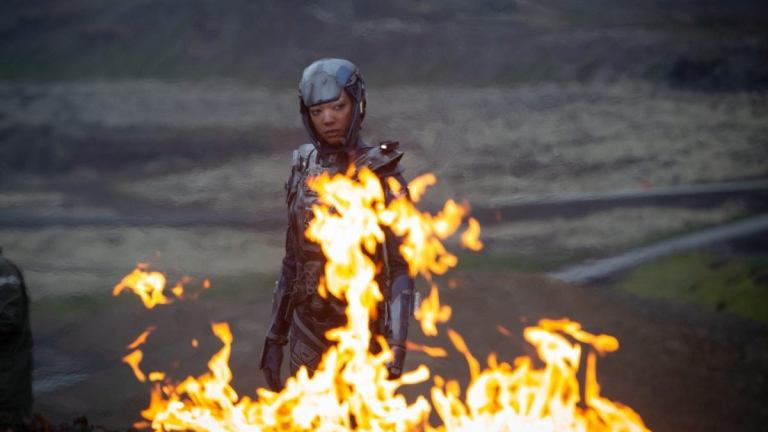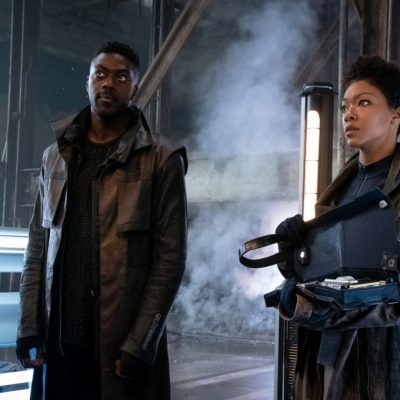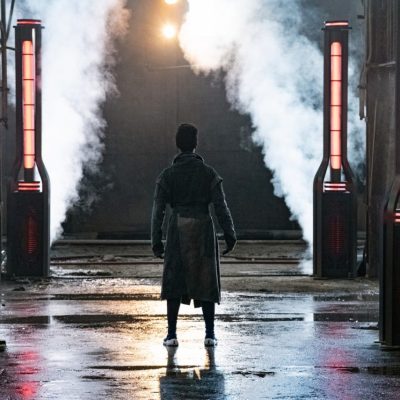What Is the Burn? Star Trek: Discovery Season 3’s Biggest Mystery Explained
The game-changing event which reshaped the Star Trek galaxy has been revealed in the Discovery Season 3 premiere. Here’s what we do and don’t know about the mysterious event known as “The Burn.”

This Star Trek: Discovery article contains major spoilers for the Season 3 premiere.
When Burnham runs into Book’s ship in the first episode of Star Trek: Discovery Season 3 — “That Hope Is You, Part 1” — she’s set-up to spend the rest of the first episode asking a lot of questions. This is science fiction worldbuilding 101: Make your protagonist a fish-out-of-water, that way, the audience can learn about the kooky rules of this new sci-fi world right alongside your hero. In Seasons 1 and 2 of Discovery, Burnham quoted from one of Spock’s favorite books, Alice In Wonderland and Alice Through the Looking Glass. But, in Season 3, Burnham doesn’t bother quoting these books. Basically, from a narrative point-of-view, she is Alice, and the man known as Book is her Cheshire Cat. Well. He has a cat, but you get it. Burnham is unstuck in time and space, and in an attempt to get herself grounded, needs to figure out the who, what, where, when, and why of everything going on around her.
The biggest what question Burnham has in episode 1, is actually a straight-up WTF. “What is the Burn?” And the answer to that question looks like it will shape not only the rest of Discovery Season 3 but, possibly, the entire future-history of Star Trek.
What is The Burn?
This question is answered outright by Book (David Ajala) in the Discovery Season 3 premiere. After Burnham presses Book to clue her in on events that happened “100, 150” ago, here’s how he describes The Burn:
The Burn was the day the galaxy took a hard left. Dilithium, most of it just went boom…The Federation couldn’t say what happened or if it would happen again… they tried to hang on..but after a while, they just weren’t around anymore.
Burnham points out that dilithium is at “the heart of every warp-capable ship.” So, The Burn created a scarcity of dilithium, but also, seemingly made everyone nervous about using it. Basically, interstellar travel post-Burn is riskier than it used to be. That said, dilithium is still pretty much the only way for most ships to get around, which is why Book is so desperate to get a hold of some in the first episode of Discovery Season 3.
What are the post-Burn implications for Star Trek tech?
Throughout the Star Trek franchise, the ability to travel at warp speed — or to exceed the speed of light by several intervals — is described as a controlled reaction between matter and antimatter. The role dilithium plays in this process is to control the reaction and regulate it. That said, one has to infer that warp drive — at least warp 1, the speed of light — is possible without dilithium, since it seems unlikely that Zefram Cochrane had any dilithium crystals on Earth in 2063.
Still, throughout Trek’s history, worrying about dilithium and its scarcity has been a big deal. In the Discovery Season 2 episode “An Obol for Charon,” Stamets mentions that the ecologies of several planets have been ruined by dilithium-mining. In the TOS episode “Mirror, Mirror,” the Enterprise is trying to negotiate with a pacifist race called the Halkans, specifically to get them to give up their crystals. In both the Short Treks episode “Runaway,” and the movie The Voyage Home, the idea of a “dilithium recrystallization” becomes tech that everyone relies upon quickly. In “That Hope Is You, Part 1” Book mentions that his “dilithium recrystalizer” doesn’t work anymore, which might imply that nobody else is able to pull that off either.
More pointedly though, in the TNG episode “Force of Nature,” it’s revealed that warp speed itself is bad for the fabric of spacetime, and as such, warp speed limits had to be enforced to prevent the galaxy from being torn apart. By the time of Voyager, warp nacelles had been redesigned to avoid harming spacetime. But what Discovery Season 3 might be suggesting is that perhaps those warp engine revisions weren’t enough.
In terms of warp alternatives, Book says “Quantum Slipstream” — a tech that Voyager tried out — doesn’t work, and also mentions that “Tachyon Solar Sails are slow as shit.” In the DS9 episode “Explorers,” Ben Sisko built an ancient Bajoran ship that operated on Tachyon Solar Sails. Basically, none of this stuff will get anyone where they are going fast enough, so Book, and everyone else, still need dilithium to warp, even if it is rare and dangerous.
Why did The Burn happen?
This is the big question that Star Trek: Discovery Season 3 has to answer. And, it seems possible that they may take a big chunk of the season to figure it out. In the short term, the shortage of dilithium means it’s harder for people to get around the galaxy unless they have it. And even if they do, it doesn’t guarantee they’ll be safe traveling through space. Obviously, the USS Discovery doesn’t appear in the first episode of Discovery Season 3, but when it does, it could be a game-changer. After all, the experimental Spore Drive on that ship doesn’t rely on dilithium exclusively. Instead, DISCO is unique because it can travel enormous distances on mushrooms!
Will the Discovery’s Spore Drive save the future of Star Trek tech in the 31st Century? The rest of Discovery Season 3 might hold the answer.


